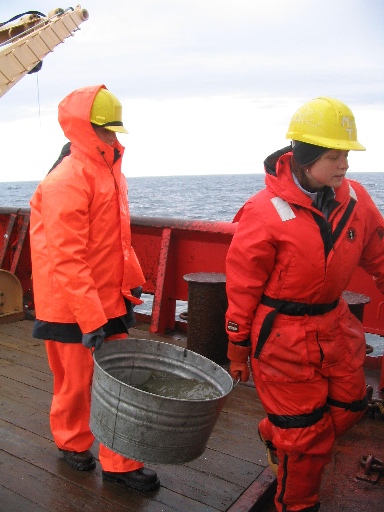( Log In ) Log In is for TREC Teachers & Researchers only
  |
| Betty_Carvellas |
 Jul 17 2005, 11:37 PM Jul 17 2005, 11:37 PM
Post
#1
|
 TEA Teacher    Group: TEA Teacher Posts: 41 Joined: 6-July 05 Member No.: 20 |
July 16, 2005
Today will be a very busy day, with four mud stations and thirteen CTD stations that will most likely run throughout the night. Some of the CTD stations are for water and others are only for Rebecca Woodgate's work with the moorings. However, a few people will need to be available for all the stations; it's going to be a long night for some of the science crew! In addition, it's gotten considerably colder and the wind has picked up. That means Mustang suits for some of us out on deck. Check out the picture below to see just how flattering they are! They are, however, very warm and, more importantly, water proof.  I admit, I started this journal early yesterday (the 16th) morning, and I'm working on it again at 3:20 AM in between CTD casts. Eight of the ten members of the science team are working to get water from these casts; Bill is no longer on board, and Rebecca Woodgate is getting some sleep since she'll be up as soon as we're done around 6 AM for mooring work. Since I do have some "mud work" pictures (I stopped waiting for a nice day to take them), I'll tell you more about what we do. At each station where we collect mud, we'll take five bottom samples with the van Veen grab and three with the HAPS core. The van Veen scoops up mud from the bottom, we sieve it to clear the mud, and then preserve the organisms left behind. When the first sample is brought to the surface, Ari or Rebecca will take small samples for the top of the van Veen before it is dumped for sieving. These are for TOC (total organic carbon), HPLC (high profile liquid chromatography - to analyze the pigments in phytoplankton) and chlorophyll-a. They'll also fill a large Marinelli beaker with mud that Lee will take back to the University of Tennessee to analyze for Beryllium-7 and Cesium-137. Since Beryllium-7 is found naturally in the atmosphere and has a half life of only 53 days (the time it takes for ½ the sample to decay), Lee can use this measurement to determine areas of recent sedimentation. He also uses the Cesium-137 (in the atmosphere from the above ground nuclear testing of the early '60's) as an indication of how long the sediments have been there. Cesium is soluble in seawater and it also attaches to clay particles on land and in freshwater. Thus, cesium washed into the ocean on clay particles can provide an indication of whether fine clay particles are accumulating in areas of the Bering Sea with high current flow. The other samples are all taken to get an idea of the ecology at the bottom (what lives there and how it interacts with its environment).  When the van Veen grabs are done, Jackie will send down the HAPS core to get a core sample of the bottom. When she gets two good undisturbed cores, with a layer of sea water on the top, she'll take those for her respiration experiments (more about that later). Ari and Rebecca will take the other core for additional sediment chlorophyll-a and another sample for HPLC. They then take one centimeter sections for the first 4 centimeters, packing, canning, and freezing the mud from each section.  One of the interesting things we noticed today was that we found far less amphipods (small, pink shrimp-like animals) in the mud grabs than we had in the past. I only had last year for comparison, but even I noticed a decline. Ari mentioned that, in the past, the entire mesh on the bottom of the sieve boxes would be covered in the slime casings that these organisms make. Check out the picture to see what they look like in the corner of the sieve box. The area we were sampling today has the exact kind of sandy mud they like to live in, but we found relatively few. The numbers are significant, because these are the primary food source for the gray whales, and the whales have been moving north to find new sources of food.  |
  |
1 User(s) are reading this topic (1 Guests and 0 Anonymous Users)
0 Members:

|
NSF Acknowledgment & Disclaimer | Time is now: 18th November 2024 - 06:20 AM |
Invision Power Board
v2.1.7 © 2024 IPS, Inc.








